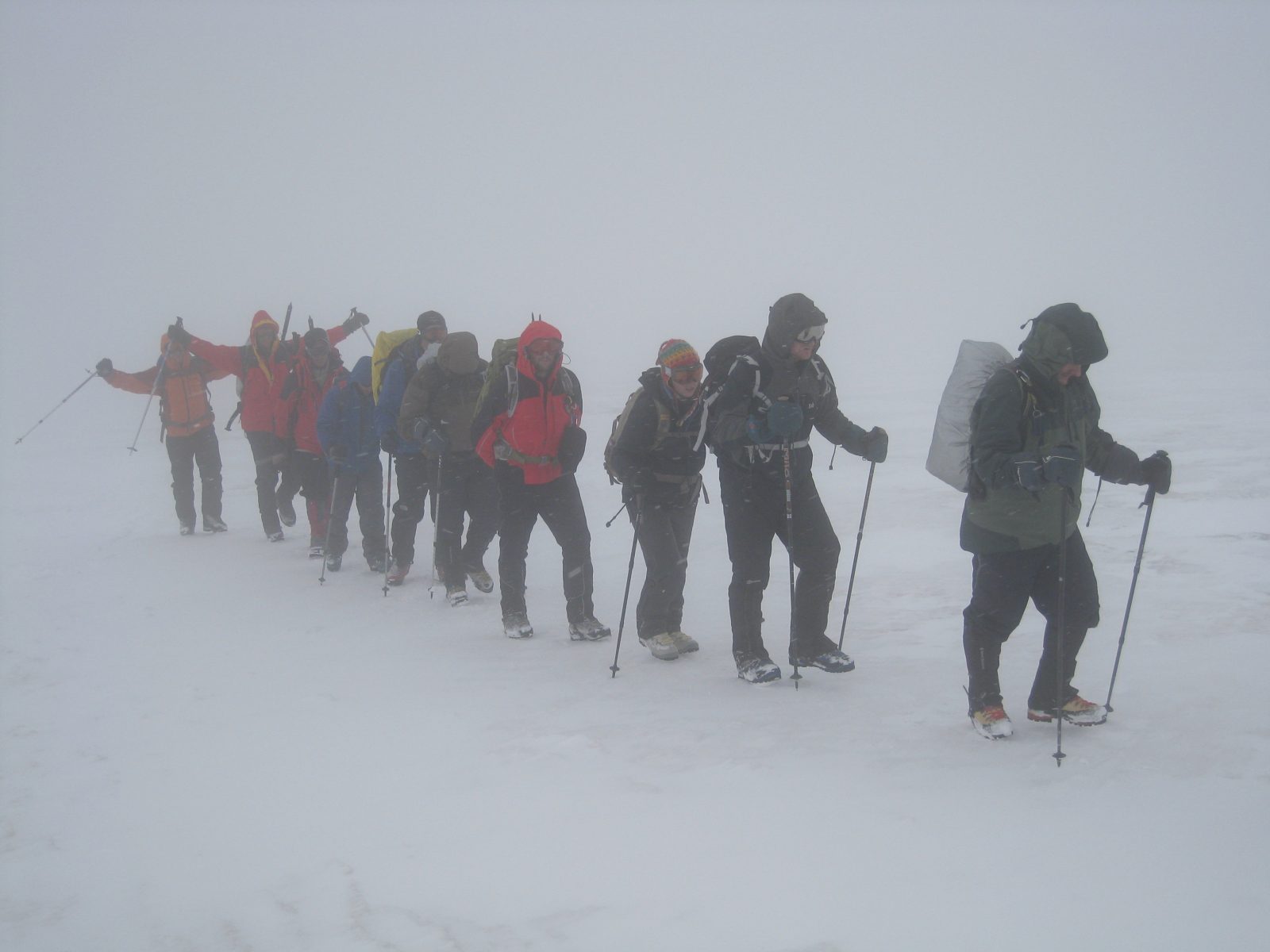
Elbrus Safety
This page describes the dangers of Mount Elbrus, rescue procedures and also some thoughts on managing summit day scenarios.
WHAT IS THE ROUTE LIKE ON ELBRUS?
The south face route is the most popular with huts above the snowline extending from 3800m to 4100m. Most people make use of a ‘ratrack’ or piste groomer to transfer up to Pastukhov Rocks at 4650m which still leaves a long summit day ascent of 1000m which takes around 7 – 10 hours.
The north side is not as facilitated, it’s a wilder more remote experience. It’s not technically difficult, about a PD alpine grade, but it’s a 1900m ascent on summit day which is commonly between 12-16 hours. There are a few huts on the moraine at 3750m, and a small higher campsite at Lenz Rocks which is 400m higher.
To get to the higher west peak, climbers have to traverse through the long col between the two peaks and join the south route, or potentially ascend directly to the summit plateau.
Make sure you read our page on preparing for Elbrus so you are well informed before going on this trip
HOW DANGEROUS IS MOUNT ELBRUS?
There are no major crevasses or objective dangers on the main routes on either the north or south sides, but the weather is very temperamental and visibility can drop rapidly. Sudden storms and extremely cold weather are common, even in the height of the summer season during July and August. It is easy to become disorientated when the cloud comes in and wander off route, and there are many stories of frostbite and cold weather injuries on the mountain every year.
Altitude is high enough to need proper acclimatisation and increased liquid intake during the climbing period. Summit day is a long day on the hill with a significant gain in elevation so it is vital to take plenty of liquid and lots of snacks and energy gels. Even on a day of fine weather, the ascent is exhausting and very challenging. Success will depend a lot on hydration, plenty of good food and rest, good acclimatisation and a lot of willpower.
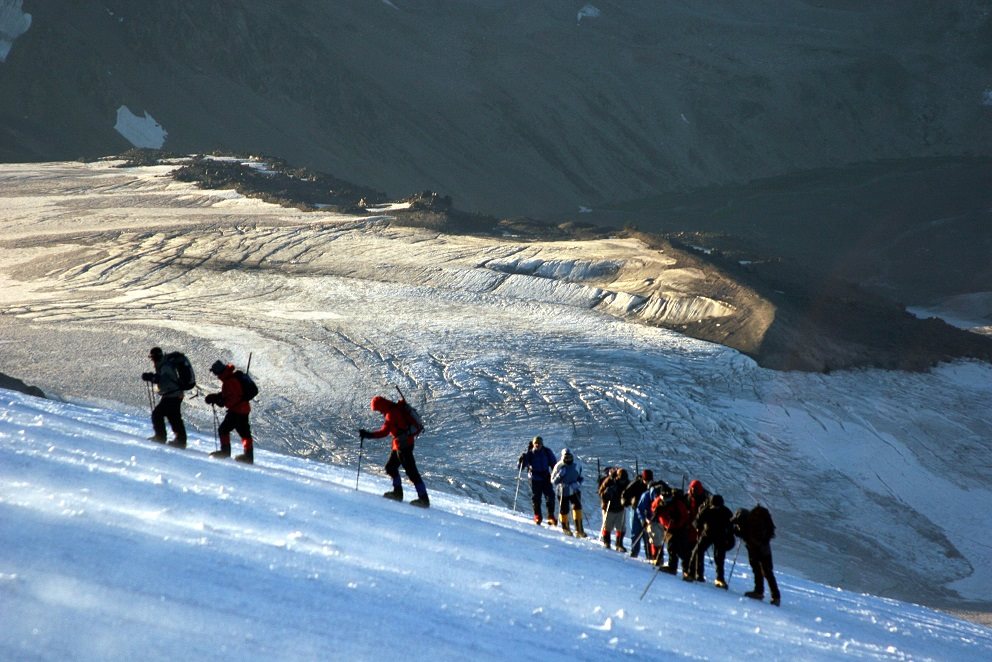
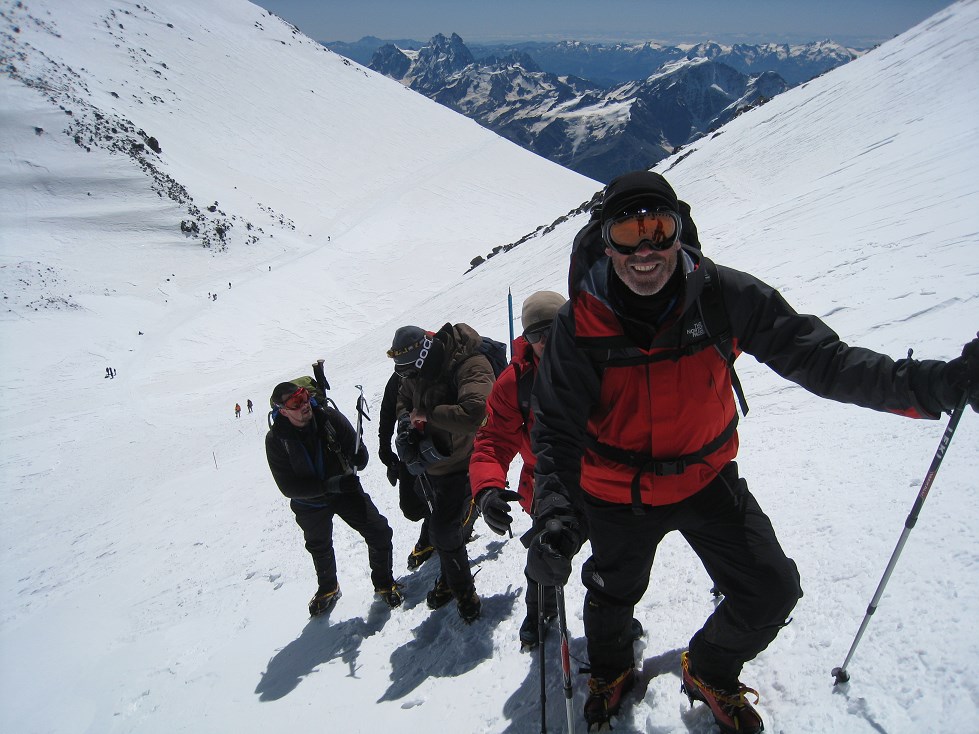
WHAT EQUIPMENT DO I NEED FOR CLIMBING ELBRUS?
Consider Mount Elbrus to be a winter climb needing basic alpine skills on a non-technical but snow-covered slope at altitude. You will need crampons, a walking axe, a helmet, mountaineering boots, a harness with slings and karabiners to clip into a rope, a proper mountain down jacket and down mitts as well as your layers of fleece and shell. See the Preparing for Elbrus page for the full kit list and more information on preparing for a mountain expedition.
Crampons are needed once you go above the snowline and a walking axe is necessary for self arrest and walking poles with snow baskets are also a must. A climbing helmet is recommended; the danger is not from falling rock, but a head injury occurring during a slip or fall. A harness with locking carabiners and a sling is necessary so you can clip into the fixed-line above the Saddle, and we would recommend an alpine harness because it is easier and safer to put on with boots and crampons.
The guides will carry ropes in case of an emergency or if they feel that someone would benefit from being roped up, particularly on the descent.
For north route expeditions, you will additionally need a four-season sleeping bag (a three-season bag would suffice on the south side because the huts can be quite warm) and a sleeping mat but the equipment otherwise is much the same.
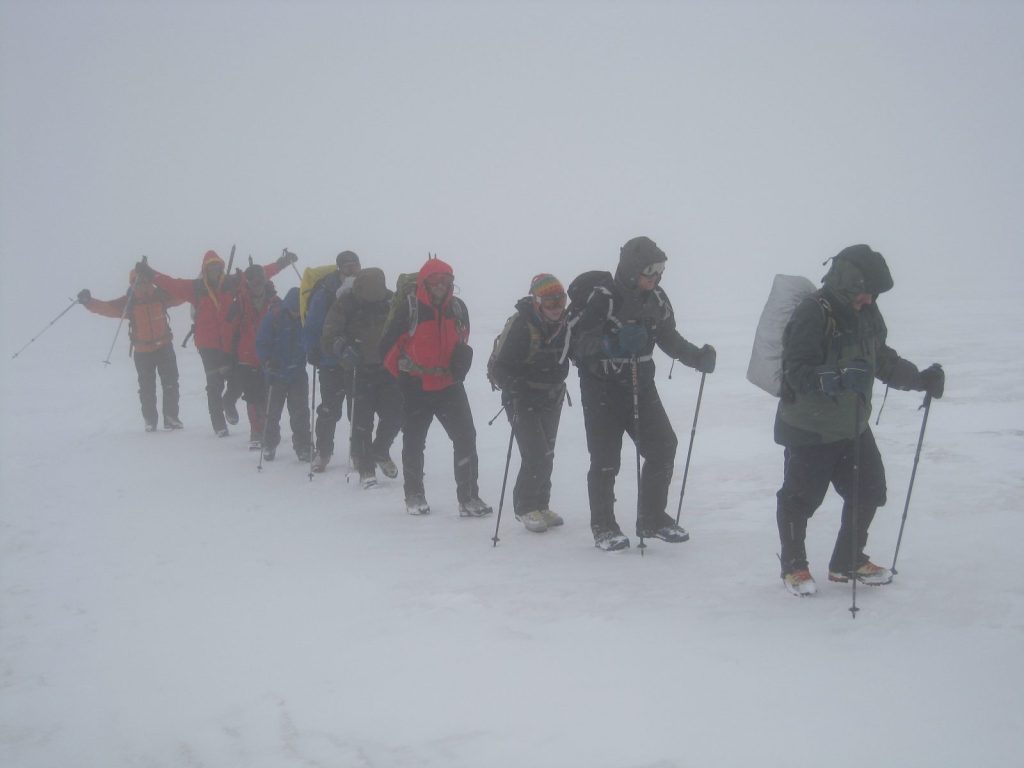
IS THERE A FIXED LINE ON ELBRUS?
On the South face route above the Sedlowina Saddle – the huge snow basin between the east and west peak – there is a fixed line in place for added safety on the rising traverse up to the summit plateau. This means that you can clip in and be held in the event of a slip on that section which is the steepest on the mountain. It’s also potentially icy.
To clip in you will need your harness and a sling and two screw gate karabiners. Use one karabiner to attach the sling to your harness, and use the other karabiner to attach the sling to the fixed line. When you come to an anchor point on the fixed line make sure you are safe and stable, and then move the karabiner across the anchor to the line and screw it shut again. It’s a simple safety system but you will also need your walking axe and pole for support.
On the North route there are no fixed lines, but the guide might lead the group through the Saddle to ascend by this way. Or the guide may make a direct ascent from the other side of the saddle up to the plateau and would likely rope everyone together on a man rope.
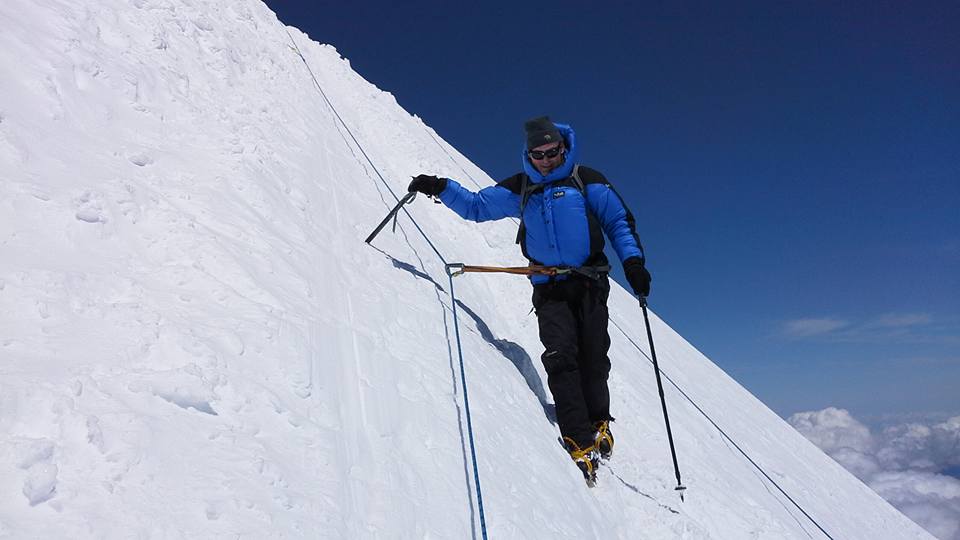
WHAT HAPPENS IN AN EMERGENCY ON MOUNT ELBRUS?
In the event of a rescue or an emergency, the guides will manage the situation along with the mountain rescue team (on the south side only) using mobile phones, as there is some signal on the mountain. However above the Saddle there is no signal so any situation above that point has to be self-managed.
A rescue will involves an assisted descent down the mountain using primarily the tracked vehicles and manpower on the south side, and only manpower on the north side.Snowmobiles and ratracks can get up to 5000m in the right conditions and take casualties to the chair lift. Theoretically someone could be down in the valley in a matter of a few hours.
If climbers on the north side have travelled through the col then it would be sensible to descend the south side to the village. Otherwise, an injured person would need to be assisted all the way back to the snowline at the top hut which would be very difficult.
Casualties are generally taken to the nearest hut and kept warm and safe until a decision is made to move further down the mountain. On the south side, this can be done with the ratrack vehicles and then transferred to the cable cars to get to the village in less than an hour. On the north side, an injured person would need carried or assisted with manpower to the base camp and then taken by car to the nearest town and hospital which adds further hours to the evacuation.
For all of these evacuation scenarios there is no external assistance, and a helicopter is not a possibility because of the difficulty of landing on the mountain at high altitude. Every rescue becomes a group responsibility and other mountain guides will help. On Elbrus the mountain rescue team is made up from all the local mountain guides and during the season there will always be other people to help and rely on. Inevitably the snow cats play a big part in rescues.
Common reasons for rescue are exposure due to the cold, exhaustion and collapse due to a combination of the cold, tiredness and altitude.
IS THERE AN EMERGENCY SHELTER ON ELBRUS?
If an accident occurs in the saddle, or people become benighted for some reason, between the two peaks there is an emergency shelter with room for two or three people to sleep if necessary and a group to rest if the weather is bad. This hut is painted a bright orange. There are no supplies inside but it offers shelter and is a useful place to gather resources before descending.
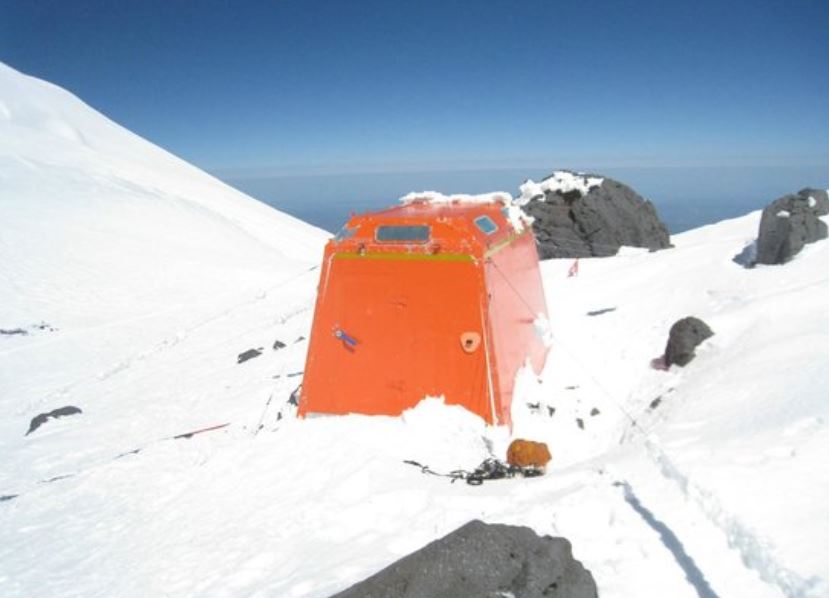
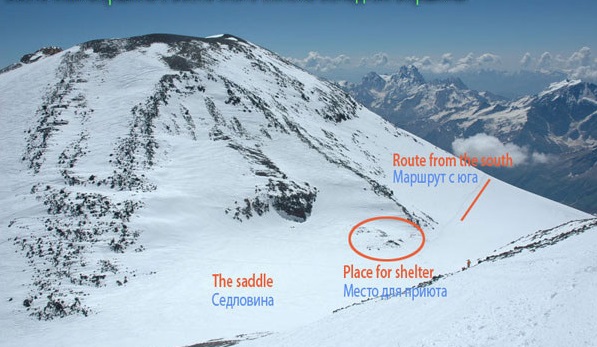
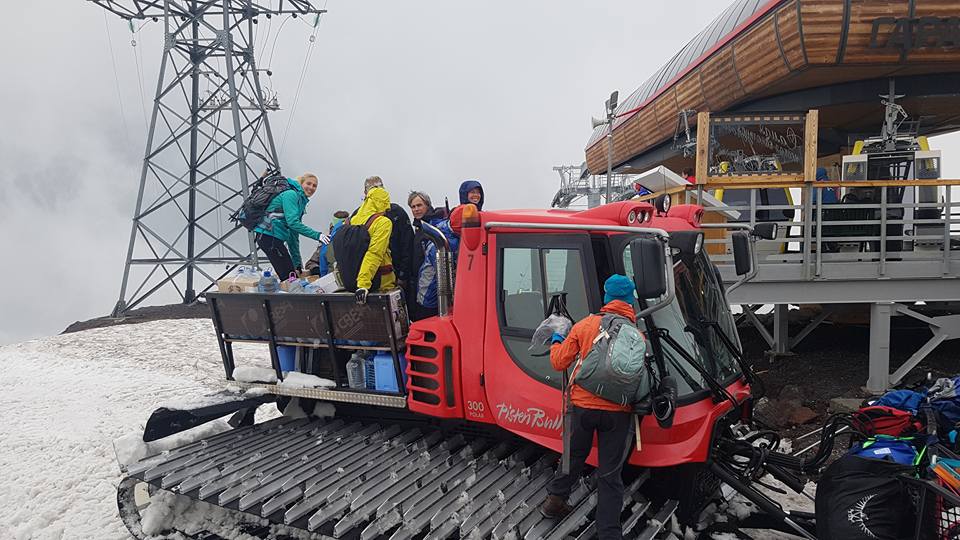
The snow machines or ‘ratracks’ on the south side of Elbrus are often used to help casualties off the mountain but they charge for the service. The amount depends how high they have to try and reach, which can be 5000m in the right conditions. Otherwise it is possible to get this high with a snowmobile.
WHAT IS SUMMIT DAY LIKE ON ELBRUS?
On both sides of the mountain the summit day is long and arduous, cold and demanding, but not technically difficult. Mount Elbrus is quite a symmetrical volcano so the gradients on each side are similar, but the north side has none of the facilities of the south side so it’s more committing. The pictures below show each route and the altitudes.
Summit day on the south side is usually made shorter because a snow machine drops people off at Pastukhov Rocks (4700m), while on the north side there’s no choice but to walk all the way. There is more on this subject on the Preparing for Elbrus page.
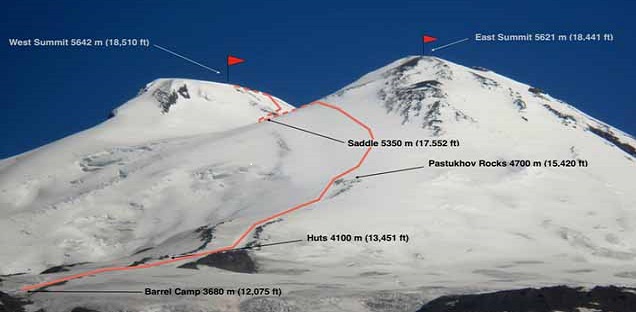
WHAT HAPPENS IF THE GROUP SPLITS UP ON SUMMIT DAY?
It is possible sometimes that the guide can manage for some people to come down with one of the guides if they are tired or unable to continue. However if there is an accident or someone becomes incapacitated then he will require that everyone in the team assists with the descent, and he will likely call a snow machine to come up as far as possible to help evacuate the casualty.
The ideal aim is to keep everyone together. The guide will make his or her decisions based on safety, and cannot allow ‘fast’ and ‘slow’ teams just for the sake of it. Neither should the guide succumb to any calls from clients for the group to split up on summit day, however close to the summit, if he deems that it will affect the safety of any individual in the team.
If some people want to go down because they are too tired or exhausted and it is possible to split the team safely, then one guide will descend with those people and the rest can continue to the summit with the other guides. However the aim is to maintain a safe ration of guide to clients, and not end up with too few guides on the summit ascent. So the number of groups can descend is limited. If it reaches a point that the ratios become unworkable and safety is threatened then everybody will have to descend. This is why generally the guide will mention certain points on the mountain where a turnaround is possible, for example in the Saddle.
WHERE IS THE NEAREST HOSPITAL TO MOUNT ELBRUS?
On the south side, the nearest hospital is in Nalchik, about an hour and a half by car from Terskol, although there is a small clinic in the village of Azau at the base of the mountain. There are several local Doctors in the villages but they are limited in what they can do to assist. A casualty would have to be taken by vehicle to Nalchik.
On the north side, the nearest hospital is in Pyatigorsk which is close to Mineralnye Vody. To get there would mean driving a 4×4 from base camp back across the river and along the off-road tracks to the road and then to the city, a total journey time of about 5 hours.
In all situations, any payments for use of the snow machines would need to be made in cash and recovered later from insurance. The insurance company can help with the repatriation of somebody from the airport to get home but they would be unlikely to make direct payments to a Russian hospital, so therefore you should expect to pay with cash or perhaps a credit card.
IS THERE MOBILE PHONE SIGNAL ON ELBRUS?
On the south side there is mobile phone signal from the high huts down to the phone towers in the valley but only generally in clear weather and with good line of sight. Above the Saddle there is no signal at all. However in the huts at about 3800m now there is wifi.
There is some mobile signal on the north side from the top hut but none at all at base camp and nothing from the higher points on the mountain.
DECISIONS MAKING ON ELBRUS
The guide will make all decisions about summit day in discussion with the other Russian guides on the mountain and taking into account all the factors. They will always work together for the benefit of everyone and often collaborate on summit day in order to keep teams together for safety.
Be patient with the language barrier even though most guides do speak good English. Russian guides are not known for their loquaciousness!Culturally they are unlikely to provide lengthy briefings and justifications for decisions. They take the view that clients should accept a guides decision as correct, and not require explanations. This is a cultural interpretation of the relationship between a guide and a foreign client. They may feel that they cannot properly explain the nuances of a decision. While the decision is based on safety and care for the client, some people may feel frustrated by the reticence. The best way to handle this is to ask questions without being confrontational.
If you would like to climb Elbrus and choose a route then please refer to the main Climbing Elbrus page and choose your preference.
Book Your Adventure of a Lifetime Now
Discover our trips to other Countries
Adventure Alternative Articles
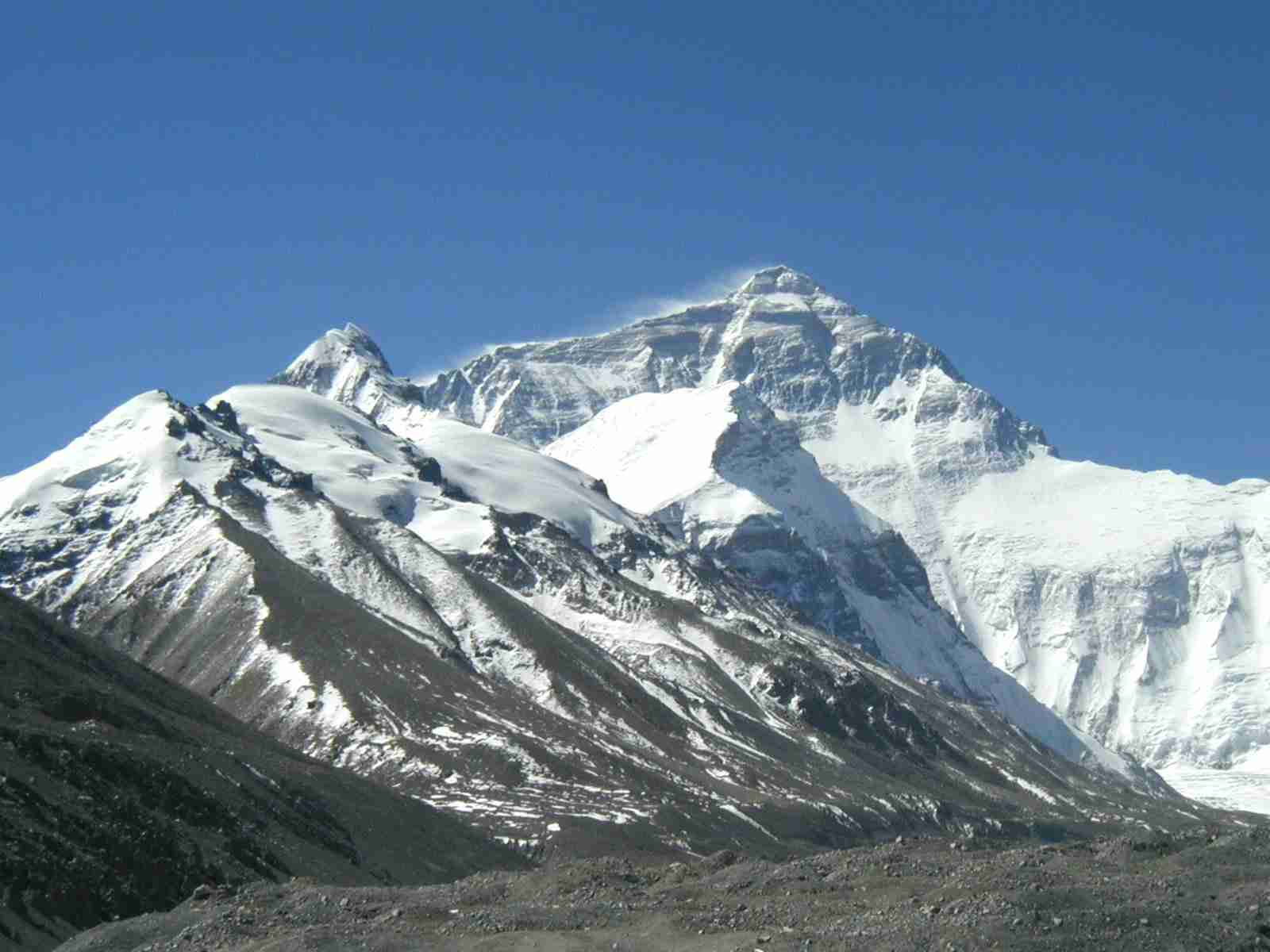
12 MONTHS, 12 MOUNTAINS
Climbing Calendar Ready for World Mountain Day In celebration of World Mountain Day, we've created a calendar for the year to make it easy for...
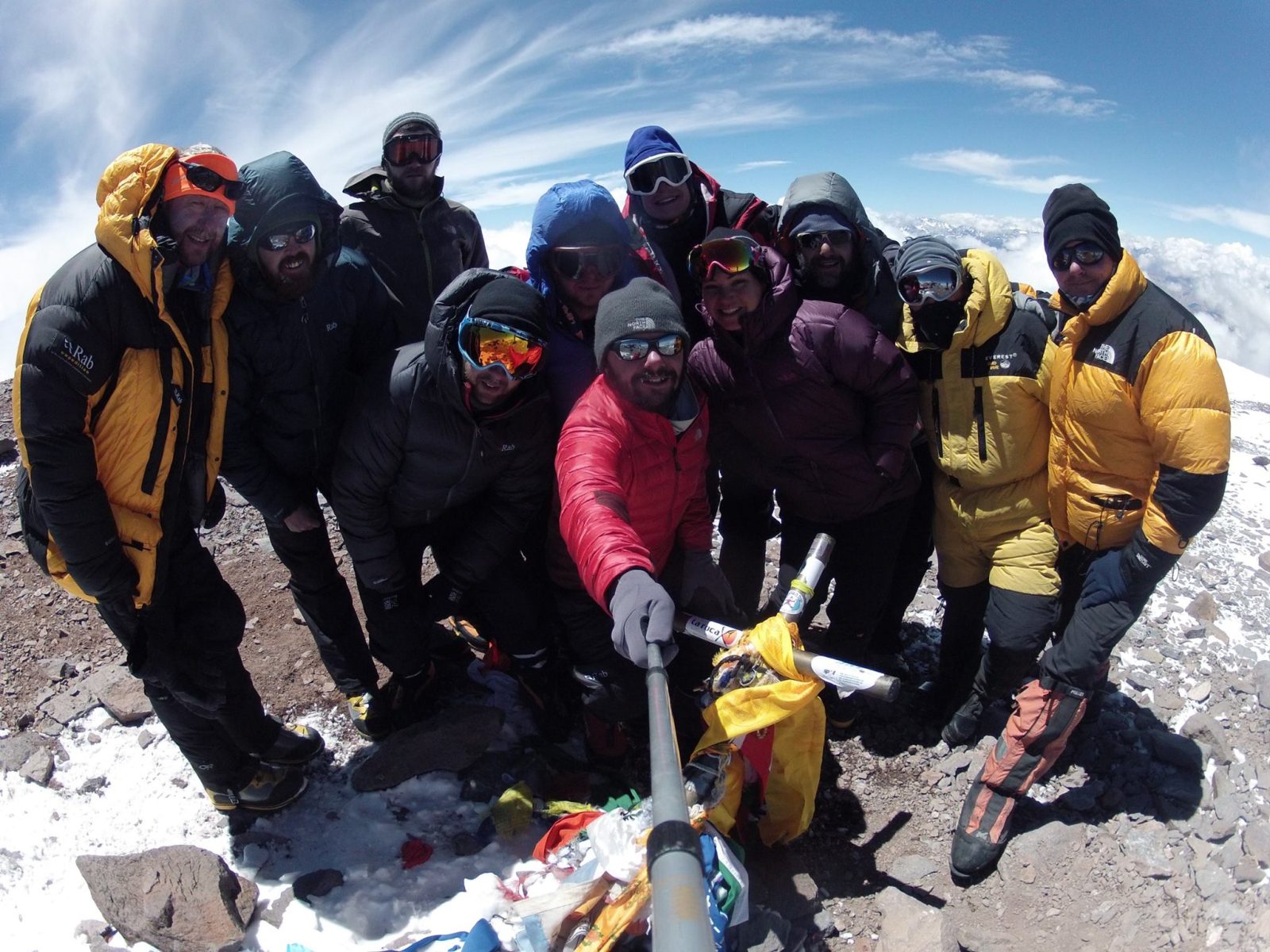
Mount Aconcagua Trip Review
January 2016 This year we had a team of twelve clients from four different countries – Iran, Ireland, England, South Africa and Argentina –...
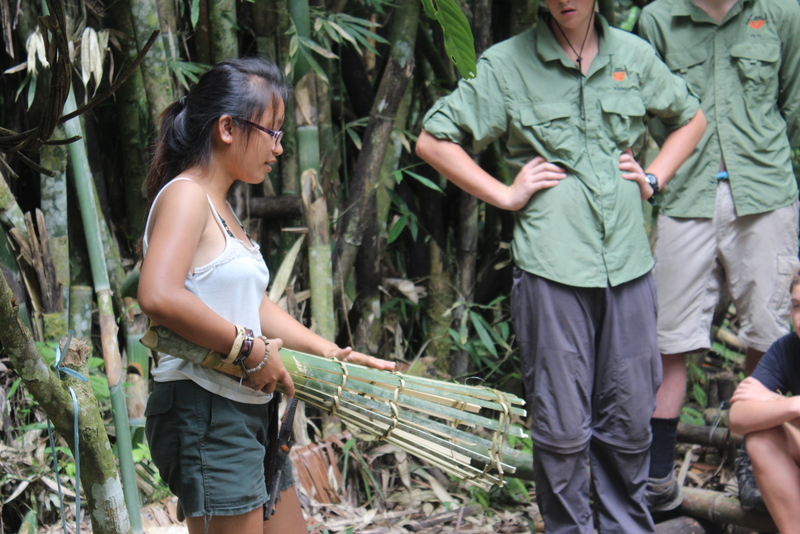
Alcey’s Survival Skills Course at Lupa Masa Jungle Camp
SURVIVAL SKILLS COURSE AT LUPA MASA JUNGLE CAMP | ADVENTURE ALTERNATIVE In celebration of International Rural Women’s Day, we’re talking...